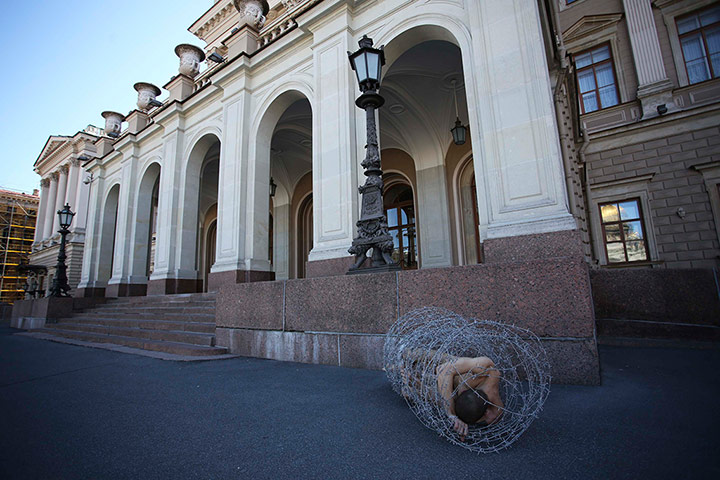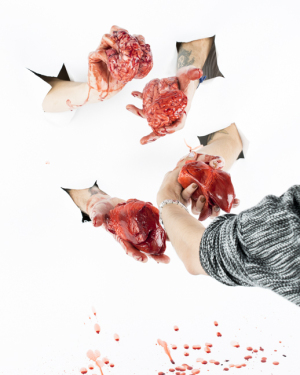
Fadi Yazigi, a Syrian artist, has not let the issues happening in Syria stop him from creating art. Since the Syrian Civil War began in 2011, the art scene has disappeared. Also, with all of the issues and violence happening in Syria, Damascus is not a safe place. Yazigi explains that “in 2013–14 there were bombing events every day. I gambled with this situation.” No matter what, Yazigi walks to his studio to create every single day, even with the risk of getting killed. It is also a difficult task for Yazigi to create this art because he uses clay from the areas that ISIS is now destroying. With so much violence surrounding this city, what this artist is doing is a rarity. As an act of resistance, Fadi Yazigi creates art to document what is going on there. Also, this is a huge risk as it is seen as defiant. With all of the corruption taking place, freedom of speech is not granted to Syrian people and people could potentially be punished for it. Yazigi, in a sense, is rebelling against the war and refusing to submit to the corruption. The art culture in the city of Damascus, however, was not always been this way. In the mid 1900’s, the Syrian government funded a big art program at the Faculty of Fine Arts at the University of Damascus. This program supported innovation and creativity. Between 2004 and 2011, the art in Damascus flourished and many galleries arose. It was a huge part of their culture and very valued by Syrian people. However, when Syria turned into a war zone, the art activities no longer took place, as it was too much of a risk and war took over their land. Fadi Yazigi’s art is interesting because it obtains taboo elements that reference the issues and violence in Syria. They reference cultures whose armies raped and killed many people. This reflects the actions of ISIS in today’s world and sheds lights on the issue. With Syria in critical danger, it is very difficult to continue the art movement. Yazigi is one of the only artists continuing his art in Damascus. However, he is trying to keep it alive. It is especially difficult when the art is a physical piece. In other words, “Issues of movement, transportation, and audience make producing painting and sculpture difficult, as opposed to more easily digitized and distributed works like photography and video.” Not only does Yazigi’s pieces reflect the horrors of the war, but they also pay tribute to Damascus’ heritage and Syrian culture. Islamic state militants and pro-government forces have destroyed many of Syria’s ancient monuments and sculptures in the past years. To keep the Syrian heritage and history alive, Yazigi incorporates local materials into his sculptures. For example, he uses clay from their home soil and ink that they use to dye local fabrics. Fadi Yazigi was offered his first solo show in Hong Kong, where his art could reach a much wider audience. Marc Decrop, the owner of Yallay Gallery, offered his this opportunity due to the perseverance he had to continue his art, despite the war and the risks that it entailed. This exhibition “highlights his strengths across three disparate mediums and follows the trajectory of the war and its impact on the lives of those in Damascus.” This exhibition was a huge turning point for Yazigi’s art as it finally is able to reach many more people and it demonstrates the realities of the war. Yazigi wants to use the atrocities that are happening in the war to create meaningful art that can speak to audiences. Instead of giving in to the war and submitting himself to ISIS, he wishes to make something good out of it and display the unfortunate reality of what is happening. He feels that it is his obligation to do this and show people the truth. Through his art, “he foregrounds the human figure in order to convey the realities of horrific acts that are deeply experienced, but nevertheless unnamable.” It is amazing to me how much art can speak to people, even in times of war and devastation. Even in times of war, Yazigi risks his life to create art and serve a bigger purpose. Although Yazigi’s art does not explicitly portray violent and grotesque images, his figures captivate his audiences and show hope in the midst of despair. He incorporates Syrian heritage into his pieces to portray the hope that he has for his country and his perseverance in preserving its’ once thriving art culture. In some ways, this type of meaningful art can be a much better way to resist the corruption and evil than fighting back with violence. Also, art can captivate and influence people much more than words and speeches. People can look at Fadi Yazigi’s art and see for themselves what is happening in Syria and what he is feeling. They interpret it on their own instead of being told directly what to feel or what to do. Fadi Yazigi’s continuation of his art can potentially be seen as a crime, especially through the eyes of the government and Islamic militant. They are trying to gain power over the Syrian people and strip them of their heritage and self-expression while Yazigi is trying to build it up. In the eyes of ISIS or the Islamic militant, he is a criminal and is fighting against their power. However, he believes he is doing good by resisting them and speaking the truth. This is what is happening with many artists around the world and a topic that sparks a lot of controversy. There is a grey area of what is art and what is crime. Sometimes it is both, however, not all crime is immoral. In the case of Fadi Yazigi, his art efforts are very moral as he is defying groups that are violently controlling the world and killing many people. Sometimes, however, in trying to do something good and beneficial, aspects of criminality have to take place. References: http://hyperallergic.com/253844/an-artist-persists-in-syria-in-a-time-of-war/ http://www.scmp.com/lifestyle/arts-entertainment/article/1879511/monster-thats-devoured-everything-syrian-artists-hong







